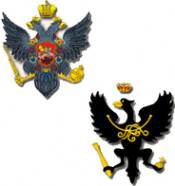
Russia and Prussia concluded the Treaty of Saint Petersburg
April 24 (May 5), 1762 Chancellor M. I. Vorontsov and the Prussian envoy, Baron R. Goltz, signed the Treaty of St. Petersburg between the Russian Empire and Prussia, which stopped the war between the two powers.
In 1750 diplomatic relations between Russia and Prussia were severed. In the summer of 1756, when the Prussian King Frederick II began the war against Austria, Russia, fulfilling the obligations under the Treaty of St. Petersburg (1746), supported Austria. Russian troops seized the entire East Prussia, and in 1760 occupied Berlin. However Peter III who ascended the throne two years later, dramatically changed the direction of Russian foreign policy. December 25, 1761 (January 5, 1762), the day of the death of Empress Elizabeth of Russia, he sent to Frederick his retinue, Adjutant General, I. V. Gudovich, informing of his accession to the throne, and with a statement of intent to restore peace and friendship with Prussia.
In March 1762, representative of Frederick II, Baron R. Goltz came to St. Petersburg charged to congratulate Peter III on the ascension to the throne. Having stayed at the Russian court as a minister plenipotentiary, Goltz started to negotiate in order to conclude a peace treaty. The Prussian king was convinced that the Russian emperor would require considerable territorial concessions, and therefore instructed Goltz to concede East Prussia. However, these fears proved groundless: Russian Emperor told Goltz that he would be happy to accept a draft peace treaty, drawn up by Frederick II. The Prussian king was not slow to take advantage of the offer and sent a draft peace treaty, which, of course, had no mention of any concessions. When Chancellor Vorontsov tried to oppose the Prussian draft, Goltz managed to obtain the full approval of the project by Peter III in a personal conversation with the emperor.
According to the St. Petersburg Treaty, the state of war between Russia and Prussia was declared ceased. Russian Emperor undertook to make efforts to restore peace in Europe, by declining in the first place from the obligations forcing him to participate in the war against Prussia. All Prussian territories occupied by Russian troops were returned to the King of Prussia and Russian troops were to retreat to their territory within the two-month period. Peter III had agreed to act as an intermediary in the conclusion of peace between Prussia and Sweden. Contracting parties also agreed to make every effort to conclude in a short time the allied treaty between Russia and Prussia.
Having concluded peace with Prussia, Peter III conceived a new war to win over the Duchy of Schleswig in Denmark. To do so, soon after signing the Treaty of St. Petersburg with Prussia, he began talks regarding the conclusion of a treaty of friendship and mutual assistance in case of an attack against one of the allied parties, which was signed on 8 (19) June 1762. The document, however, was never ratified because of a palace coup which dethroned Peter III. Having ascended the throne, Catherine II broke the treaty of alliance with Prussia, but upheld the Treaty of St. Petersburg, because Russia was in need of respite after the Seven Years' War (1756-1762).
Lit.: Петербургский мирный договор 1762 г. // Дипломатический словарь. М., 1948; Письма императора Петра Феодоровича к прусскому королю Фридриху Второму // Русский архив. 1898. № 1; Соловьёв С. М. Царствование императора Петра III Феодоровича // История России с древнейших времён. СПб., 1851-1879. Кн. 5. Т. 25. Гл. 1. С. 631—681; То же [Электронный ресурс]. URL: http://www.runivers.ru/bookreader/book54670/#page/631/mode/1up.
Based on the Presidential Library’s materials:

